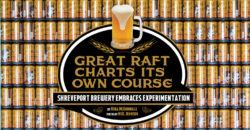Foodways
Great Raft Charts Its Own Course
The Shreveport brewery embraces experimentation to find success beyond Louisiana
Published: June 8, 2017
Last Updated: July 31, 2019
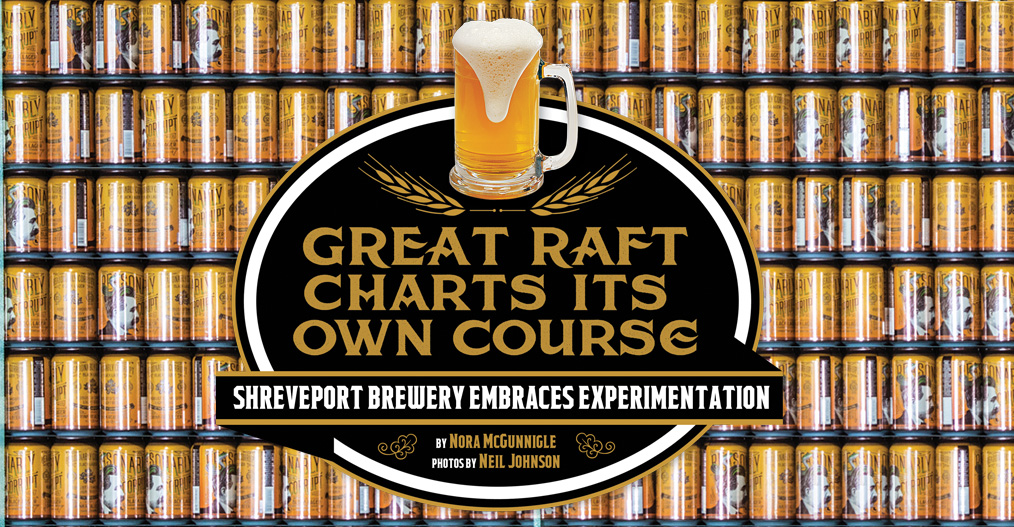
Great Raft Brewing in Shreveport has danced all over the art–science scale, brewing lagers with technical precision as well as wild-fermented beers made with cocktails of bacteria and yeast which can grow and change in unexpected directions.
Quality First
Great Raft founders Andrew and Lindsay Nations have built their solid reputation on the simple concept of quality over quantity, and they have backed that up with significant investments in equipment, manpower, and standard operating procedures from the start.
“The lab was an original part of our build-out,” says Lindsay. “You can’t really say you’re committed to quality without having the means to ensure quality.”
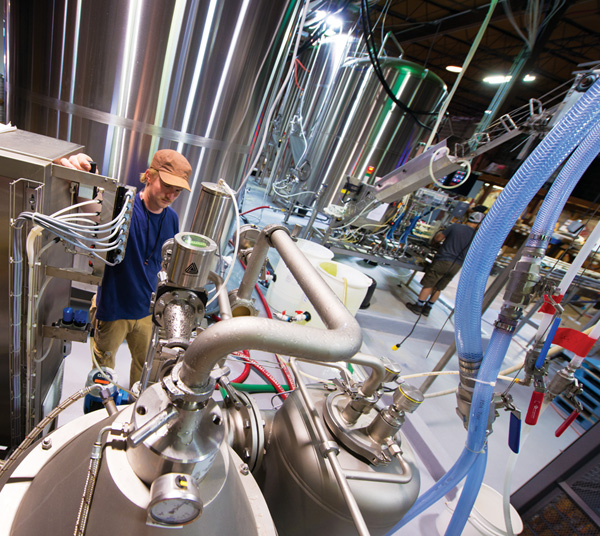
An employee monitors a centrifuge during beer separation just prior to packaging at the company’s headquarters in Shreveport.
The lab is a crucial feature in quality control as well as research and development. It’s been staffed by dedicated and qualified personnel from day one, says Andrew, and has evolved over time, with the gradual addition of equipment to monitor yeast in the fermentation tanks, to ensure it’s doing what it needs to do at the appropriate rate, as well as breaking down the yeast from previous batches to single-cell isolates to rebuild it to the brewery’s exact specifications and culture it for future batches of beer.
This kind of investment in quality, typical of large breweries and budgets, exceeds expectations for a newer brewery of Great Raft’s current size.
Andrew and Lindsay opened Great Raft Brewing in 2013, after years of meticulous planning, which started when the Shreveport natives and high school sweethearts were living and working in Washington, DC. They were active members in the DC beer scene and decided to move back in 2012 to foster a craft beer culture in their hometown.
Along with head brewer Harvey Kenney, a graduate of University of California–Davis in brewing science and a biochemist by trade, the Nations began by releasing two lagers—one pale and one black—and a pale ale. The approachability of these beers was geared toward the area’s beer market, which was at the time macro-produced. The simplicity of the styles belied the complex series of steps required to ensure perfect execution, such as balanced recipe development, water chemistry, yeast measurement, and temperature control.
“With lagers, you have to be very aware of your fermentation techniques, when to crash your beer, and know when it’s done,” Andrew says. “Brewing lagers isn’t hard, but having that conviction to drop a batch if it’s not right, and having that awareness of what great lager tastes like is critical.”
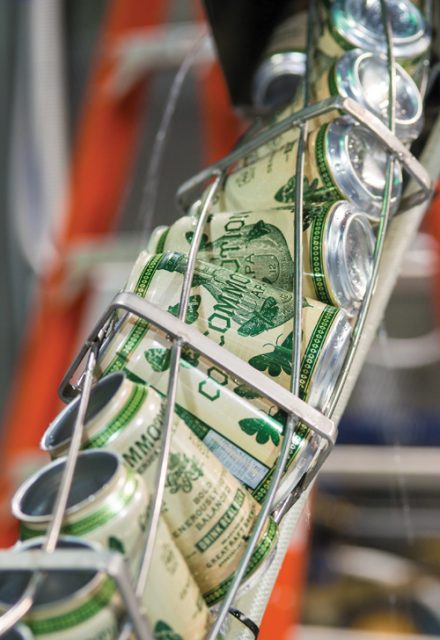
Cans of the Commotion American Pale Ale being processed and packaged in the canning line.
Back To The ‘Drawl’ing Board
It was this attention to consistency that led to the reformulation of its flagship beer, Southern Drawl Pale Lager. When the year’s harvest yielded hops that contained half of the bittering agents—alpha acids—that the recipe called for, the team couldn’t get the exact flavor they wanted, no matter how many tweaks were made. This was the impetus to go back and recreate the recipe from the beginning.
If we’re going to change this beer, the team reasoned, we need to look at it holistically, and think about what people want from it. Going back to the name, Southern Drawl, Andrew says, was the most important starting point. “There’s nothing Southern about that beer,” he notes.
As is typical of a pilsner or pale lager, the majority of the malts and hops are from the style’s birthplace in Germany, Andrew explains. “So if we redo it, let’s make it southern.”
Louisiana is well-known for its rice farming industry, and rice is an ingredient that’s been used by massive breweries such as Budweiser for decades. Labeled an “adjunct” ingredient, rice has long been frowned upon by small brewers for being used as a cost-cutting, flavor-attenuating measure. However, the new formulation uses a large quantity of rice, which emphasizes and brings its flavor qualities—including a refreshing crispness—to the forefront of the beer.
The new version of the beer will be a hoppy pilsner, with a hint of American hops behind the traditional German ones.
“We’ve been working on the recipe for about 6 months, trying to dry it out, and figure out what American influence we want in the dry hopping stage,” Andrew says. “But Southern Drawl is 30 percent of our sales. It’s kind of scary, but we have that conviction to make the best beer we can.”
Enemies of Beer
An important—but often overlooked—consideration is the fate of the brewer’s fresh beer when taken by a distributor to sell in stores and bars. Once it’s out of the brewery’s hands, they have no control over storage temperature or length of time the product sits on the shelf. Light, heat, and age can degrade beer quickly through a process called oxidation, making it taste stale or like wet cardboard.
“It matters so much how you package the beer.” says Andrew. “In Louisiana, the beer spends so much time on the shelf. The best way to ruin a beer is to take a great beer and package it poorly. Even with a phenomenal beer. It’s heartbreaking to have your beer, or someone else’s, that you fundamentally know is a great beer, ruined with that oxygen. It’ll kill you.”
In order to keep the high quality of Great Raft’s beer in the market, the Nations invested in a powerful, but pricey, centrifuge to make sure all the protein and hop particles are separated from the beer. These solids, as well as the packaging process itself, create the dissolved oxygen that ages a beer prematurely. The hazier the beer is, the more yeast and hops are present in the liquid when it reaches the market, which breaks down into oxidation even more rapidly.
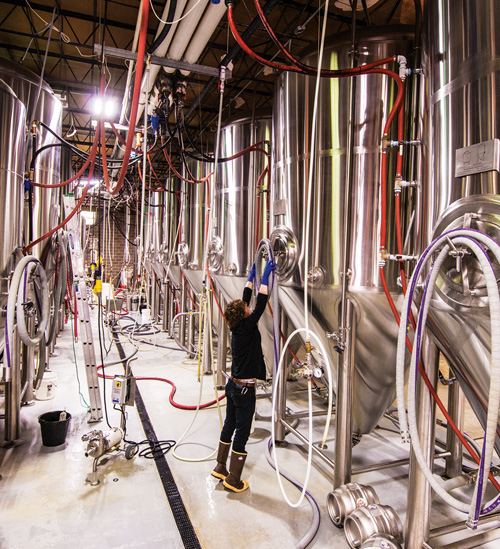
A brewery attendant works between two rows of fermenters.
According to Andrew, Great Raft is “basically spinning all that out and creating a much more stable product with a better shelf life.”
“Our quality controls are very progressive for a brewery this size,” Andrew notes. “We don’t have the same budget of the larger breweries but we hold ourselves to the same quality of standards.”
Letting Go
The illusion of control is challenged when brewing beer that includes non-traditional fermentation agents such as Lactobacillus, a bacteria that imparts a tart or sour flavor to beer, or Brettanomyces, a type of yeast that brings an undertone of earthiness and barnyard funk to both taste and aroma. When these microorganisms interact with the beer’s ingredients and fermentation conditions, it’s difficult to predict precisely what the end product will be.
At Great Raft, these beers are created in a completely separate section of the brewery, so as not to infect the traditional lagers and ales on the “clean” side. The Nations call the “dirty” side of the brewery its “Belgian program,” since these sour-funky techniques have been kept alive in small family breweries in Belgium for generations before finding a wider popularity in the American craft beer scene.
According to the Nations, they built the Belgian program to be everything the clean program is not. “The three core beers there—Farmhouse Slang, You Me and Everyone We Know, and Oceans Between Us—will change every time,” Andrew says. “If you’re expecting consistency out of that, you’re not going to get it. We’re very vocal about that.”
When brewing a beer like Southern Drawl, on the other hand, he knows with a high degree of certainty what the end result will be. “We can manipulate and control a lot of different variables on the clean side. But a lot of time, with our dirty beer, we don’t even create our labels until that beer’s packaged. Then we can describe what actually happened. Maybe we thought it was going to be one thing, but then it went in another direction.”
The Long Game
It comes back to prioritizing quality above all else. Creating a standard and doing everything possible to uphold that standard. It’s the not-so-secret to success that’s true in all industries. In the rising world of craft beer, however, there’s an increasing divide between breweries perpetuating a laid-back DIY attitude that served them well in humble homebrew beginnings and breweries who understand that punching above their weight class means investing in technology and planning for growth.
“It’s very difficult, when all these breweries are growing fairly fast, to stop and invest in something that doesn’t actually get more beer out the door, but a brewery’s most expensive beer is a bad beer released to the public. Because that’s our reputation,” Andrew says.
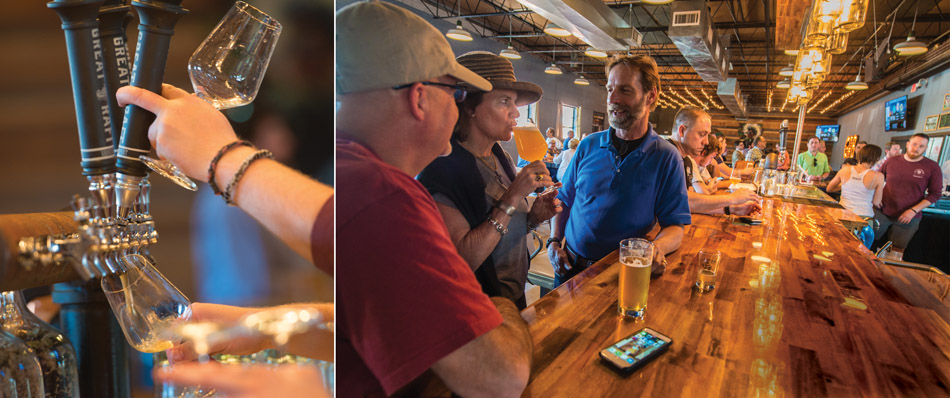
Visitors sample the product in the Great Raft taproom, located next to the brewery in the Historic Fairfield District.
Innovation in brewing isn’t about the newest, the shiniest, or the trendiest. It’s taking long-term perspective and making decisions about the future, even if it takes a few years for those decisions to pay off. It’s scrutinizing technical details while managing human assets and creating a space in the community. But brewers and brewery owners who can balance the art and science of making beer, like Great Raft, will grow into the plans they made when they started the journey.
Nora McGunnigle is a freelance beer and food writer based in New Orleans. Her work has appeared in Beer Advocate, All About Beer, Louisiana Kitchen & Culture, Thrillist, Where Magazine, and other regional and national print and online publications. Her website is nolabeerblog.com.
